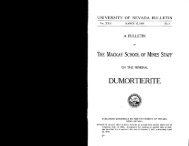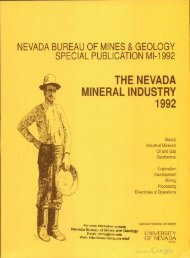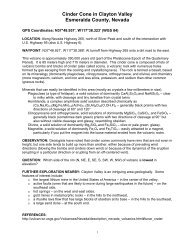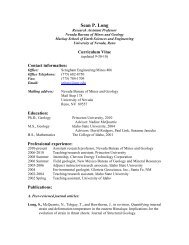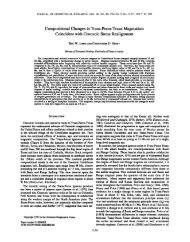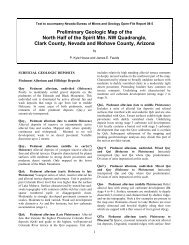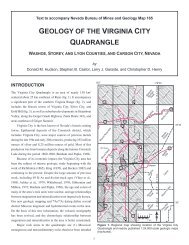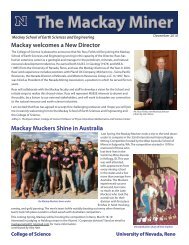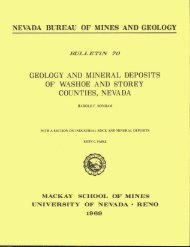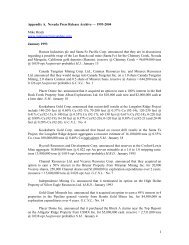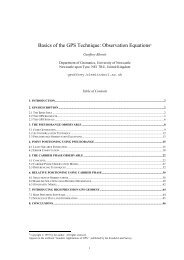Nevada Bureau of Mines and Geology - University of Nevada, Reno
Nevada Bureau of Mines and Geology - University of Nevada, Reno
Nevada Bureau of Mines and Geology - University of Nevada, Reno
You also want an ePaper? Increase the reach of your titles
YUMPU automatically turns print PDFs into web optimized ePapers that Google loves.
ocks <strong>of</strong> the upper member <strong>of</strong> the Natchez Pass Formation. Some<br />
mineralization also occurs in limy shales <strong>of</strong> the Lower Grass Valley<br />
Formation. The chief host rock for the gold mineralization is a silicified<br />
carbonate breccia which has been interpreted as a debris flow <strong>and</strong> as a<br />
breccia in the sole <strong>of</strong> a thrust fault. Extensive areas <strong>of</strong> jasperoid occur<br />
in the mine area <strong>and</strong> much <strong>of</strong> the ore is silicified carbonate breccia.<br />
Locally abundant fluorite is present in the ore zone. The ore averages 30<br />
m thick <strong>and</strong> is oxidized. The ore zone continues both to the east <strong>and</strong> west<br />
<strong>of</strong> the mine area, but the depth <strong>of</strong> overburden becomes too great for<br />
economic recovery <strong>of</strong> the gold. The announced reserves are 8 million tons<br />
grading 0.035 ounce per ton gold as <strong>of</strong> September, 1984.<br />
The mercury deposits occur in the southern part <strong>of</strong> the Antelope<br />
Springs district in limestone breccia <strong>of</strong> the Dun Glen Formation <strong>and</strong> in<br />
dolomite conglomerate <strong>of</strong> post Dun Glen age. The mercury deposits are<br />
clearly localized in these stratigraphic units <strong>and</strong> this constitutes a<br />
guide to ore in the southern part <strong>of</strong> the district.<br />
The main ore mineral is cinnabar. Associated with the cinnabar in<br />
some <strong>of</strong> the mines are stibnite, pyrite, sphalerite <strong>and</strong> galena. Bindheimite<br />
<strong>and</strong> antimony oxides are also present. Cinnabar typically occurs in<br />
carbonate veinlets cutting breccia or conglomerate <strong>and</strong> as crystalline<br />
cinnabar in the conglomerate matrix. Powdery red cinnabar associated with<br />
bindheimite at the Red Bud Mine, is probably <strong>of</strong> supergene origin.<br />
The main antimony deposit in the district is the Hollywood Mine.<br />
Quartz veins, <strong>and</strong> veinlets in s<strong>and</strong>stone <strong>and</strong> phyllite <strong>of</strong> the Grass Valley<br />
Formation contain pods <strong>and</strong> lenses <strong>of</strong> stibni~e <strong>and</strong> antimony oxides. The<br />
0 0<br />
vein zone trends N40 -60 W <strong>and</strong> dips ~60'-70 E. The .wallrocks are strongly<br />
sericitized adjacent to the veins.<br />
GEOCHEMISTRY<br />
Samples taken <strong>of</strong> typical mineralized rock at the Relief gold mine are<br />
anomalous in silver, arsenic, weakly anomalous in boron, anomalous in<br />
beryllium, antimony, <strong>and</strong> lead. One sample contained anomalous copper,<br />
molybdenum, <strong>and</strong> vanadium. Three samples contained 0.55, 1.7 <strong>and</strong> 3.2 ppm<br />
gold, respectively.<br />
Geochemical data are not available at this time for the mercury or<br />
antimony mines in the district, although it is known, that in addition to<br />
mercury <strong>and</strong> antimony, the mines contain anomalous lead, zinc, <strong>and</strong> locally,<br />
gold.<br />
SELECTED REFERENCES<br />
Johnson, M. G. (1977) <strong>Geology</strong> <strong>and</strong> mineral resources <strong>of</strong> Pershing County,<br />
<strong>Nevada</strong>: <strong>Nevada</strong> <strong>Bureau</strong> <strong>of</strong> <strong>Mines</strong> <strong>and</strong> <strong>Geology</strong> Bulletin 89, p. 115.<br />
Wallace, R. E., Silberling, N. J., Irwin, W. P., <strong>and</strong> Tutlock, D. B. (1969)<br />
Geologic map <strong>of</strong> the Buffalo Mountain Quadrangle, Pershing <strong>and</strong> Churchill<br />
Counties, <strong>Nevada</strong>: U.S. Geological Survey Map GQ821.<br />
Antelope Springs District - 2



